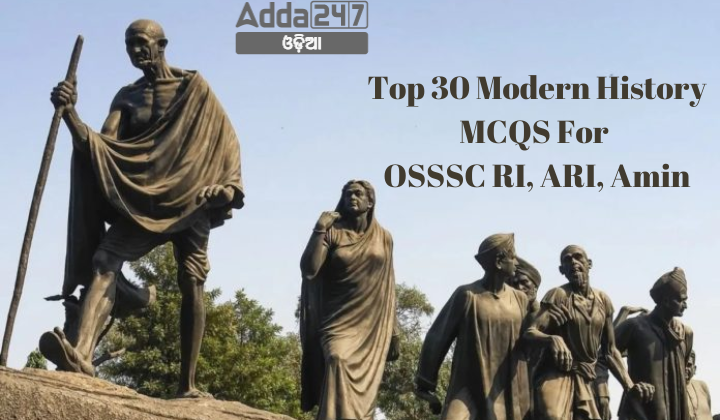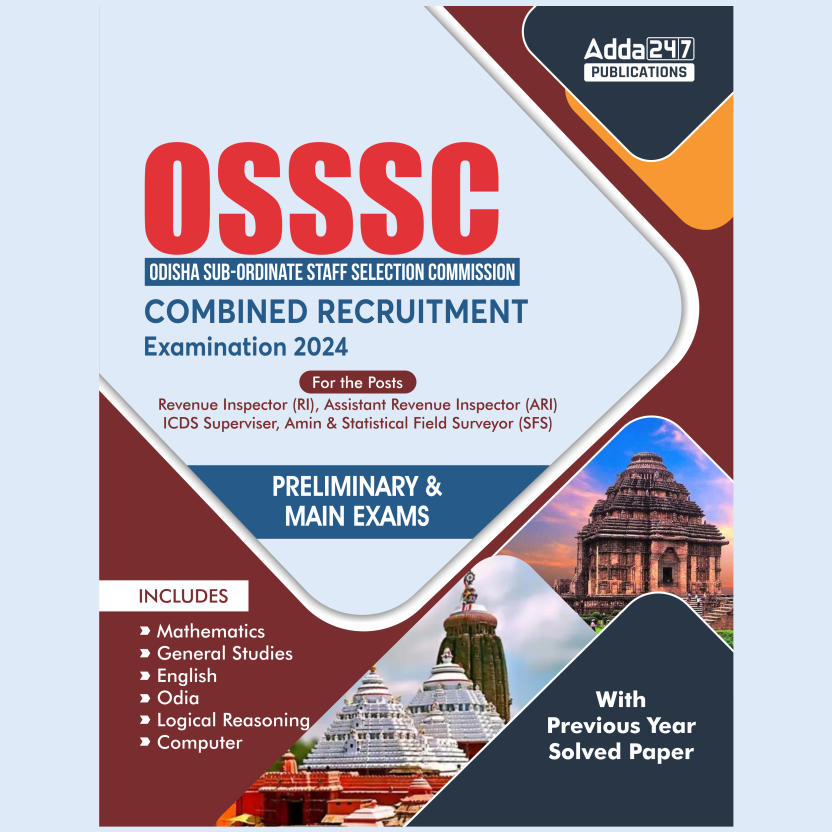Preparing for competitive exams such as OSSSC RI (Revenue Inspector), ARI (Assistant Revenue Inspector), Amin, SFS, or ICDS Supervisor often requires a strong grasp of historical events. Modern history, especially, forms a significant part of the syllabus, covering crucial periods and events that shaped the world as we know it today. To aid in your preparation, here are 30 multiple-choice questions (MCQs) focusing on modern history:
Top 30 Modern History MCQs for OSSSC RI,ARI, Amin, SFS, ICDS Supervisor
- Which of the following acts extended the East India Company’s rule over British territories in India for another 20 years?
(a) Regulating Act 1773
(b) Charter Act 1793
(c) Charter Act 1813
(d) Government of India Act 1833
Ans: (b) Charter Act 1793 - Under the Charter Act 1793, the acquisition of sovereignty by the subjects of the Crown in India was considered to be on behalf of the ____?
(a) East India Company
(b) British Parliament
(c) British Crown
(d) Board of Control
Ans: (c) British Crown - What percentage of dividends was the East India Company allowed to raise under the Charter Act of 1793?
(a) 5%
(b) 7%
(c) 9%
(d) 10%
Ans: (d) 10% - Which official was granted the power to override his council’s decisions under the Charter Act 1793?
(a) Governor of Bombay
(b) Governor of Madras
(c) Governor-General of India
(d) Commander-in-Chief of India
Ans: (c) Governor-General of India - Under the Charter Act 1793, who had the authority over the governors of Madras and Bombay?
(a) Secretary of State for India
(b) British Crown
(c) Governor-General of India
(d) East India Company’s Directors
Ans: (c) Governor-General of India - According to the Charter Act of 1793, in the absence of the Governor-General from Bengal, who could be appointed as the acting head?
(a) Commander-in-Chief of India
(b) Senior-most military officer
(c) Vice President from the civilian members of the Council
(d) Chief Justice of the Supreme Court
Ans: (c) Vice President from the civilian members of the Council - Which of the following was a change in the composition of the Board of Control as per the Charter Act 1793?
(a) Introduction of an additional member from the Privy Council
(b) A President and two junior members not necessarily from the Privy Council
(c) A merger with the Court of Directors
(d) All members being chosen from the British Parliament
Ans: (b) A President and two junior members not necessarily from the Privy Council - The Charter Act 1793 separated which two functions of the East India Company?
(a) Judicial and administrative
(b) Revenue and military
(c) Revenue and judicial
(d) Administrative and military
Ans: (c) Revenue and judicial - Under the Charter Act 1793, which of the following was considered illegal for senior company officials without permission?
(a) Trade within India
(b) Leaving India
(c) Appointing deputies
(d) Engaging in politics
Ans: (b) Leaving India - The Charter Act 1793 granted the East India Company the authority to issue licenses for trade in India. This was commonly known as ____.
(a) Country trade
(b) Trade monopoly
(c) Sovereign trade
(d) Privilege trade
Ans: (a) Country trade - When did Maharaja Ranjit Singh establish himself as the ‘Maharaja of Punjab’?
(a) 1780
(b) 1799
(c) 1801
(d) 1839
Ans. (c) 1801 - Which title was bestowed upon Maharaja Ranjit Singh for his valor and leadership?
(a) Maharaja of Lahore
(b) Sher-i-Punjab
(c) Lion of Lahore
(d) Emperor of Punjab
Ans. (b) Sher-i-Punjab - Which city did Maharaja Ranjit Singh make his capital after occupying it in 1799?
(a) Multan
(b) Amritsar
(c) Lahore
(d) Peshawar
Ans. (c) Lahore - Maharaja Ranjit Singh is known for uniting how many Sikh misls under his rule?
(a) 6
(b) 10
(c) 12
(d) 15
Ans. (c) 12 - Which major treaty ended the First Anglo-Sikh War?
(a) Treaty of Amritsar
(b) Treaty of Lahore
(c) Treaty of Multan
(d) Treaty of Sobraon
Ans. (b) Treaty of Lahore - Which of the following areas were ceded to the British as per the Treaty of Lahore, 1846?
(a) Lahore
(b) Multan
(c) Kashmir and Hazarah
(d) Peshawar
Ans. (c) Kashmir and Hazarah - Who succeeded Maharaja Ranjit Singh after his death in 1839?
(a) Duleep Singh
(b) Kharak Singh
(c) Sher Singh
(d) Jindan Kaur
Ans. (b) Kharak Singh - What significant role did Sir Henry Lawrence play after the Treaty of Lahore?
(a) He led the British forces in Punjab
(b) He was appointed as the British Resident in the Sikh court
(c) He became the regent of Punjab
(d) He negotiated the treaty terms
Ans. (b) He was appointed as the British Resident in the Sikh court - Which river marked the northern boundary of Maharaja Ranjit Singh’s empire?
(a) Yamuna
(b) Sutlej
(c) Ganges
(d) Ravi
Ans. (b) Sutlej - During the First Anglo-Sikh War, the Sikh forces took offensive positions against the English in which month and year?
(a) November 1845
(b) December 1845
(c) January 1846
(d) February 1846
Ans. (b) December 1845 - Which of the following was a cause of the Second Anglo-Sikh War?
(a) The annexation of Kashmir by the British
(b) The removal of Maharani Jindan Kaur from Lahore
(c) The assassination of Maharaja Ranjit Singh
(d) The Treaty of Amritsar
Ans: (b) The removal of Maharani Jindan Kaur from Lahore - Multan, which played a crucial role in the Second Anglo-Sikh War, was originally captured by which ruler?
(a) Maharaja Duleep Singh
(b) Maharaja Ranjit Singh
(c) Maharani Jindan Kaur
(d) Sir Frederick Currie
Ans: (b) Maharaja Ranjit Singh - Who governed Multan before the outbreak of the Second Anglo-Sikh War and resisted British demands?
(a) Sardar Kahan Singh
(b) Sir John Lawrence
(c) Dewan Mulraj
(d) Dost Mohammad Khan
Ans: (c) Dewan Mulraj - What triggered the rebellion in Multan in 1848 leading to the Second Anglo-Sikh War?
(a) The arrival of new British troops
(b) The assassination of British officers
(c) The reduction of Sikh soldiers’ pay
(d) The annexation of Punjab
Ans: (b) The assassination of British officers - The Battle of Chilianwala during the Second Anglo-Sikh War resulted in a:
(a) Decisive British victory
(b) Sikh victory
(c) Stalemate
(d) Afghan withdrawal
Ans: (b) Sikh victory - Which battle marked the final conflict of the Second Anglo-Sikh War in 1849?
(a) Battle of Ramnagar
(b) Battle of Chillianwala
(c) Battle of Gujrat
(d) Battle of Multan
Ans: (c) Battle of Gujrat - Which Afghan leader supported the Sikhs during the Second Anglo-Sikh War?
(a) Sher Ali Khan
(b) Dost Mohammad Khan
(c) Ahmad Shah Abdali
(d) Amir Amanullah Khan
Ans: (b) Dost Mohammad Khan - Which treaty led to the annexation of Punjab by the British after the Second Anglo-Sikh War?
(a) Treaty of Amritsar
(b) Treaty of Lahore
(c) Treaty of Rawalpindi
(d) Treaty of Multan
Ans: (b) Treaty of Lahore - After the annexation of Punjab, who was appointed as the first Chief Commissioner of Punjab?
(a) Sir Frederick Currie
(b) Lord Dalhousie
(c) Sir John Lawrence
(d) Patrick Vans Agnew
Ans: (c) Sir John Lawrence - Which famous diamond was taken by the British as a result of the Second Anglo-Sikh War?
(a) Hope Diamond
(b) Darya-i-Noor
(c) Koh-i-Noor
(d) Regent Diamond
Ans: (c) Koh-i-Noor










